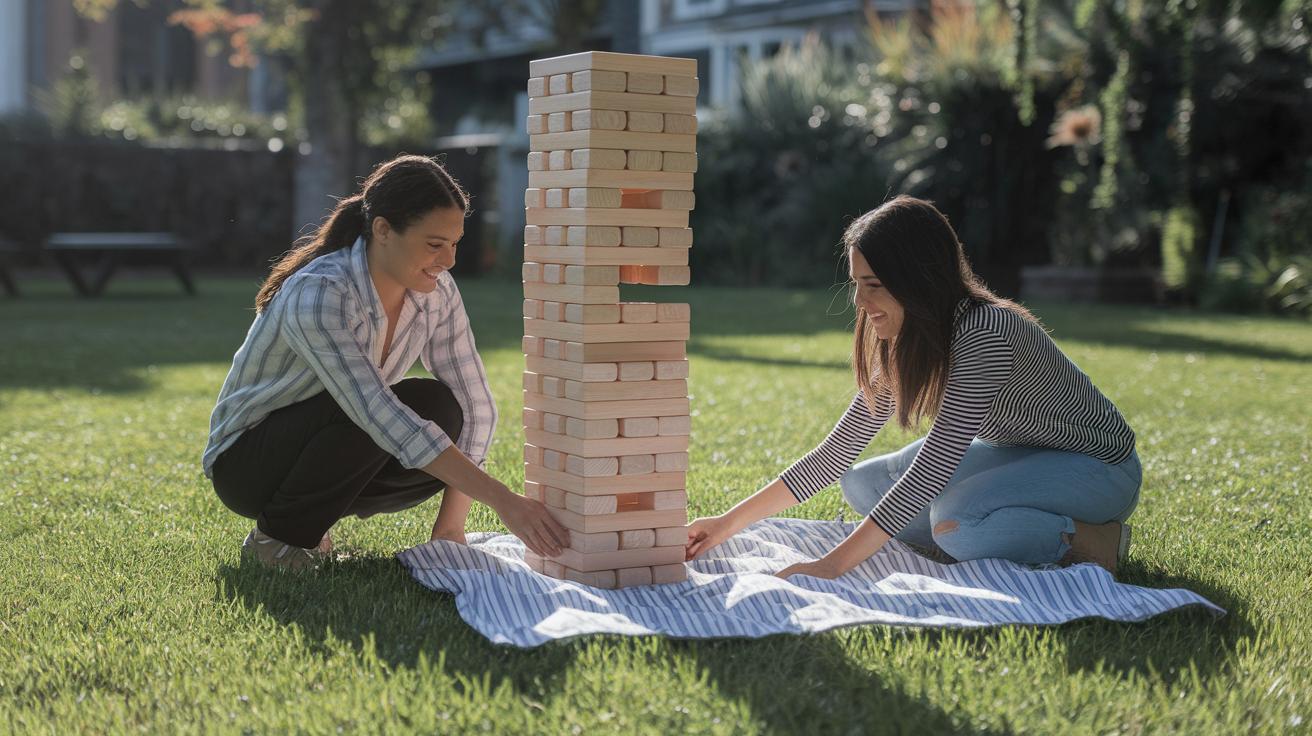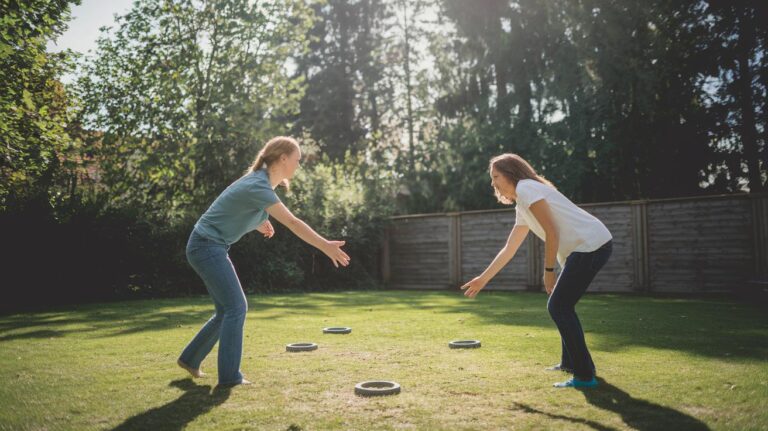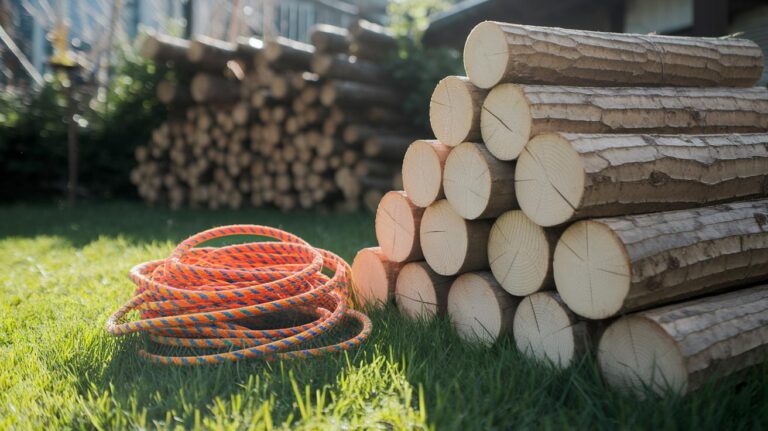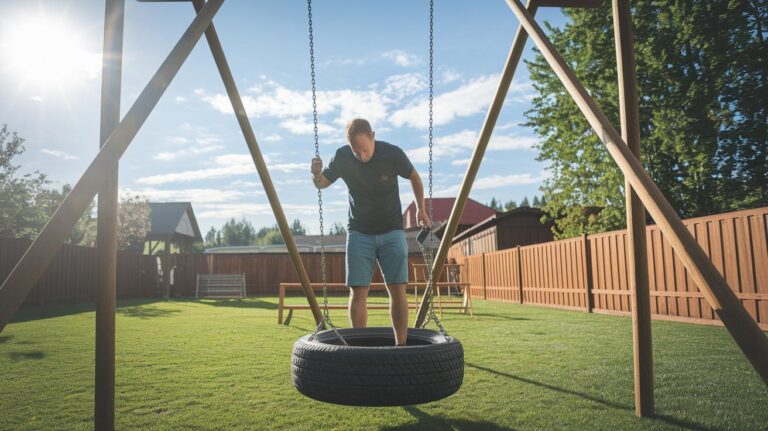Lawn Jenga Safety Tips For Amazing Outdoor Fun
Have you ever yanked a Jenga block and watched the tower wobble like an old fence post? That tumble can kill the vibe when your outdoor spot isn’t solid.
First, find a patch of grass that’s firm and flat. Walk around it, feel the blades under your shoes, you know, and clear away any sticks or little stones. Oops, I just kicked a small rock there.
Then let the morning dew dry so blocks won’t slip. Next, level the ground (make it flat) by pressing down high spots and filling low spots with a bit of soil. Back to the game.
Lastly, grab chalk or string and draw a three-foot circle around your tower. No feet or snacks allowed inside this zone. That way every pull feels steady and every crash stays fun.
Proper Ground Leveling & Site Selection for Lawn Jenga
Ever tried pulling a block and watched the tower lean before you even start? Pick a spot that feels as solid and flat as a picnic table. Firm turf (grass surface) gives your tower a steady base so blocks stay put, even when you tug at the middle.
First, scan the ground for high or low spots. Walk around, look for little hills or dips, and press down any small bumps or fill shallow holes with extra soil (dirt layer that holds plants). Then clear away sticks, small rocks, or other debris so nothing sneaks under a block and sends the stack tumbling.
Next, check turf moisture (water content in the grass). If you leave footprints or spot puddles from last night’s rain or the sprinkler, wait for it to dry. A dry surface means crisp block pulls without sliding.
Have you ever felt a gust knock over a tall stack? Use a leaf or a scrap of tissue to test the breeze. If winds top 15 miles per hour, strong gusts can wobble your tower. So either move to a calmer corner or wait for the wind to die down.
Finally, mark a 3-foot clear zone around your play area. This gives everyone room to step back when the tower falls. Before each round, every 15 to 20 minutes, give the whole setup a once-over. Spot any new dips, damp patches, or sudden gusts and fix them so the next turn stays safe and fun.
- Test level with a straight board or level tool.
- Look for damp spots and wait until the ground dries.
- Clear sticks, rocks, and other debris.
- Mark a 3-foot clear zone around the tower.
- Press down small bumps or fill shallow dips.
- Reinspect ground and breeze before each round.
Block Quality Inspection & Material Selection for Lawn Jenga

When you grab a wooden Jenga block you feel its gentle warmth in your palm. But it needs to be silky smooth with no splinters itching at your skin. If you find any rough spots just sand them down and wipe clean. You want each block to glide out easy.
Plastic blocks are tough too. They shrug off rain and sun without rotting (slow breakdown of material). They still slide when you tap them. It all comes down to a slick finish that stops blocks from catching or tearing your fingers.
- No splinters or rough edges
- Same length, width, and thickness every time
- No cracks, chips, or warp (bending out of shape)
- Store dry with no moisture
- Even weight on each block
Here’s a tip to make your blocks last. Gently wipe each one with a damp cloth. Let them air dry completely before you stack them away. And if you spot tiny wood cracks, brush on a quick coat of outdoor sealant (waterproof coating) to keep moisture out and stop decay.
Check your blocks now and then. A little upkeep keeps your Lawn Jenga game smooth and fun.
Protective Padding & Gear Recommendations for Lawn Jenga
Let’s keep your grass happy and your blocks safe. First, lay down interlocking foam floor tiles (soft squares that snap together). Then place non-skid rubber mats over any damp or uneven patches. Tuck corner padding strips along the play area edges to cushion those runaway tumbling blocks. Cover at least a three-foot radius around the tower so every piece lands on a soft foam bed instead of bare turf.
And don’t forget your gear. I like to slip on safety glasses (they catch flying dust or tiny splinters) when I reach for a sky-high stack. You can hang a little flag or sign at setup to nudge everyone about padding and eyewear rules, no one wants to forget their safety glasses mid-game!
- Interlocking foam floor tiles
- Non-skid rubber mats
- Corner padding strips
- Optional safety glasses for tall towers
Pop up clear signs at the entry and around your play zone listing the required padding and gear. That friendly reminder helps every player suit up before the first block even moves.
Tower Assembly: Height Limits & Stable Stacking Techniques
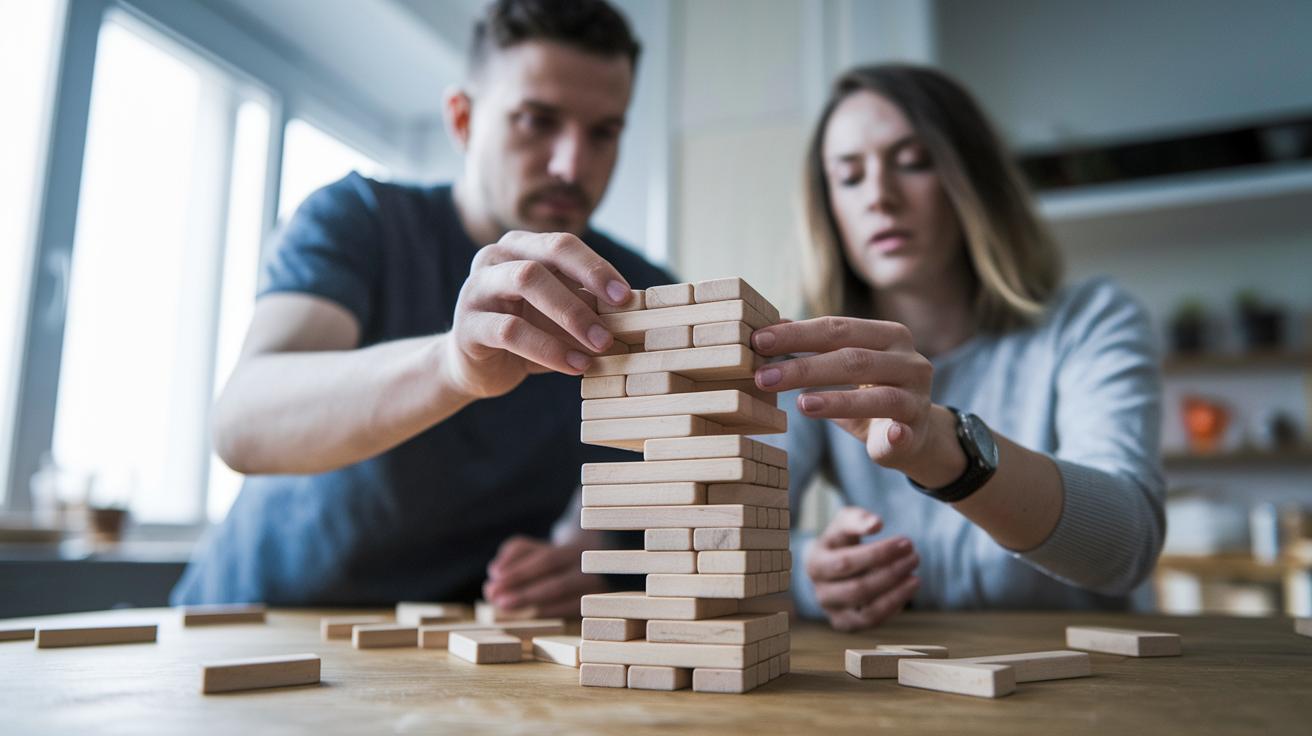
Have you ever built a block tower in your backyard? Taller than four feet, and you can almost hear it wobble. When those blocks come crashing down, they can fly right across the lawn and scare your neighbor.
A one-foot stack barely moves. It’s like a kid’s game.
Two feet is just enough thrill. Three feet? That’s a real challenge without sending blocks into the street.
But go past four feet, and things get risky faster than you’d think.
Start with a solid base. Lay three blocks side by side on firm ground (like packed dirt or a patio). Press down so they sit flat.
Slide another block along the edge. Feel for any lean (tilt). If it rocks, tap gently until it stops.
And here’s a tip: each new layer goes the other way. Turn them 90 degrees (a quarter turn) from the row below. That crisscross pattern spreads the weight and locks each level in place.
| Tower Height | Risk Level |
|---|---|
| Up to 1 ft | Low |
| 1-2 ft | Medium |
| 2-3 ft | High |
| 3-4 ft | Very High |
Keep stacking with three blocks each time. Slide your palm across the top. Any bump or tiny gap can send the tower leaning.
Press each block down until you hear a soft click. Once you reach three feet tall (about 36 inches), you’re near the top. Pause, check every seam, then add more if you dare. You’ll end up with a strong, steady tower that won’t surprise you, or your neighbors.
Defining Safe Play Zones & Spectator Distance for Lawn Jenga
Alright, here’s the first step. Level your yard until the ground feels firm and flat underfoot. Then pick a spot that’s big enough for a tall tower of blocks.
Next, draw a circle about three feet out from where your tower will stand (that’s roughly an adult’s stride). Use sidewalk chalk. That soft cloud of white dust feels oddly satisfying. Or spray paint a quick outline for something more lasting.
Then set out cones or stick stakes into the grass every five feet. You can drape bright yellow caution tape between them for a fun, eye-catching boundary.
This simple safety boundary (perimeter) shows everyone exactly where to stand when blocks come crashing down. It keeps players stepping back and curious onlookers at a safe distance while they cheer and laugh.
Supervision & Safe Extraction Methods in Lawn Jenga

You’ve laid down a soft mat and cleared a three-foot ring on your bright green grass. Now think about who’s watching the fun. One adult for every three or four players works best, especially when little hands join in. It keeps the game lively and safe.
Have you ever seen a tower wobble just as a kid lunges forward? Me too. Keep grown-ups close enough to gently guide a hand back if someone pulls too hard. And if you’ve got both kids and teens playing, pick one adult to show safe moves each turn.
Before every round, take a slow walk around the tower. Move any garden hose, stray toys, or trowels (small hand tools used for digging) out of the way. A quick sweep like this cuts down on trips and jammed blocks, worth the extra two minutes.
Remind folks to stay behind your marked ring until it’s their turn. That way fingers stay out of the top blocks. And always spot-check for wobbling before you tug a piece. Yes!
Pair younger players with a friend or a parent when it’s their turn. It’s like a little tag-team, fun and reassuring at the same time.
- Approach the tower from the side so you don’t crowd the pieces.
- Nudge the block gently with your index finger (pointer finger).
- Hold the blocks on either side with your other hand to keep them steady.
- Step back so the tower can fall away safely if it goes.
Enforce good stance rules: no kneeling or sprawling near the tower. I once saw my nephew tip over trying to lean in, oops! If someone starts to bend over, remind them to stand back and bend at their knees. You can even mark a “no-lean” zone with small stakes or flags. It builds solid habits and cuts down on those wild tumbles when blocks finally give way.
Emergency & First-Aid Preparedness for Lawn Jenga Events
When you’re stacking giant wooden blocks under the sun, stuff happens. Keep a first-aid kit (box with medical basics) within arm’s reach. Pack bandages in different sizes, antiseptic wipes (for cleaning scrapes), tweezers (to pull out splinters), a roll of gauze, adhesive tape, disposable gloves, and a couple of instant cold packs. There’s nothing like that cold pack pressed against a bump.
And don’t rely on just luck. Assign a collapse-zone spotter to call out wobbly towers. Sketch a quick emergency plan so everyone knows what to do if blocks come tumbling. You might even ask, “Who grabs the ice pack first?” before the first block ever falls.
- Assign one friend as spotter to watch for tipping blocks
- Write simple steps for falls and basic care
- Set timers for water breaks so hands stay steady and everyone stays cool
- Mark the nearest urgent care or ER and share the address and directions
- Keep an updated list of emergency contacts, especially for younger players
After the game, log any mishaps in a few lines. Oops, I once left my gloves at home, don’t let that happen to you. Note what happened, who helped, and how you treated it. That little habit makes your next Lawn Jenga gathering even safer.
Visual Guides & Signage for Clear Lawn Jenga Safety Instructions
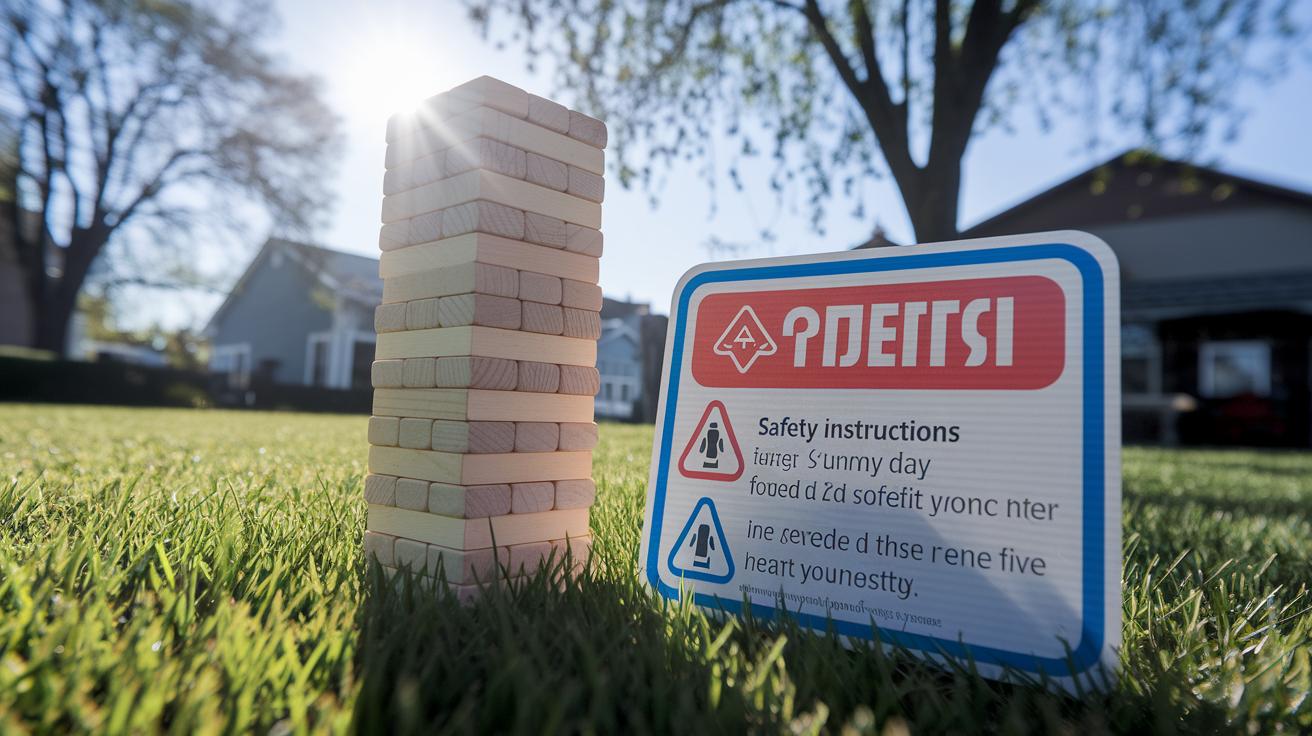
Want to keep your Lawn Jenga fun and safe? Draw a quick diagram of the tower setup. Show three blocks side by side. Then snap a photo of that gentle nudge that starts the action. Finally, capture one more shot outlining the three-foot clear zone around your tower.
Slide your safety briefing into a plastic sleeve on a small easel next to the tower. Oops, I once slipped mine in upside down – made everyone tilt their heads, but they still saw the rules. That way, everyone catches the do’s and don’ts at a glance.
Color-code your visuals. Use green for player areas, yellow for caution spots, and red for no-go zones. Big arrows pointing at block-pull angles help new players nudge safely. Numbered photo notes make it easy to follow along, even after a few rounds in the hot sun!
- Place a diagram at the tower base so players double-check the setup before each turn
- Pin a safety briefing template in the player staging area where folks line up
- Hang small warning signs around spectator boundaries to mark clear no-go spots
Final Words
You’ve leveled the ground, inspected every block, and placed protective pads. You’ve marked play zones, set height limits, planned supervision, and stocked a first-aid kit.
The blog walked you through proper ground leveling & site selection, block quality checks, padding and gear, stacking limits, spectator distance, safe extraction methods, emergency prep, and clear visual guides.
Keep re-checking moisture, monitoring wind, and refreshing your 3-foot perimeter before each round. With these lawn Jenga safety tips in your pocket, your backyard games will be safer and more fun than ever.
FAQ
How do I prepare the play surface for Lawn Jenga?
Select level, firm ground—avoid slopes—flatten bumps, remove sticks and rocks, mark a 3-foot clear zone, ensure grass is dry, and check wind is under 15 mph.
What should I inspect on blocks before playing Lawn Jenga?
Choose smooth, splinter-free wood or durable plastic. Verify uniform length, width, and thickness; check for cracks, chips, or warping; ensure consistent weight; store blocks dry.
What protective gear is recommended for Lawn Jenga?
Use interlocking foam tiles or non-skid rubber mats around the tower, corner padding strips to cushion falling blocks, and optional safety glasses for high towers.
How tall can I safely build a Lawn Jenga tower?
Limit height to 3–4 feet. Stack three blocks per level with even weight distribution and central alignment on each layer to reduce collapse hazards.
How should I mark a safe play zone for Lawn Jenga?
Create a three-foot clear perimeter marked with chalk or spray paint, reinforce with cones or stakes every five feet, and use caution tape at spectator entry points.
What technique should I use to remove blocks safely?
Approach from the side, gently nudge blocks with your index finger while supporting adjacent blocks with the other hand, then step back to clear the collapse path.
What first‐aid and emergency steps should I plan for Lawn Jenga events?
Keep a kit stocked with bandages, antiseptic wipes, and tweezers; assign collapse-zone monitors; map the nearest medical facility; schedule hydration breaks; document incidents.
How can visual guides improve Lawn Jenga safety?
Place diagrams of tower setup, removal techniques, and spectator distances at the tower base, in the player area, and around spectator boundaries as clear reminders.

